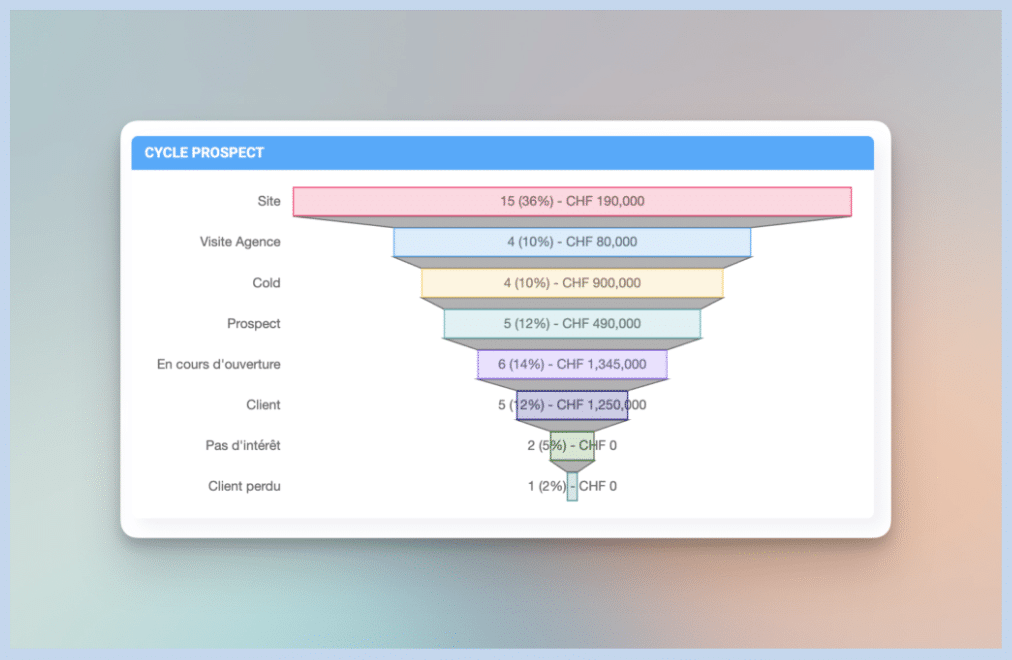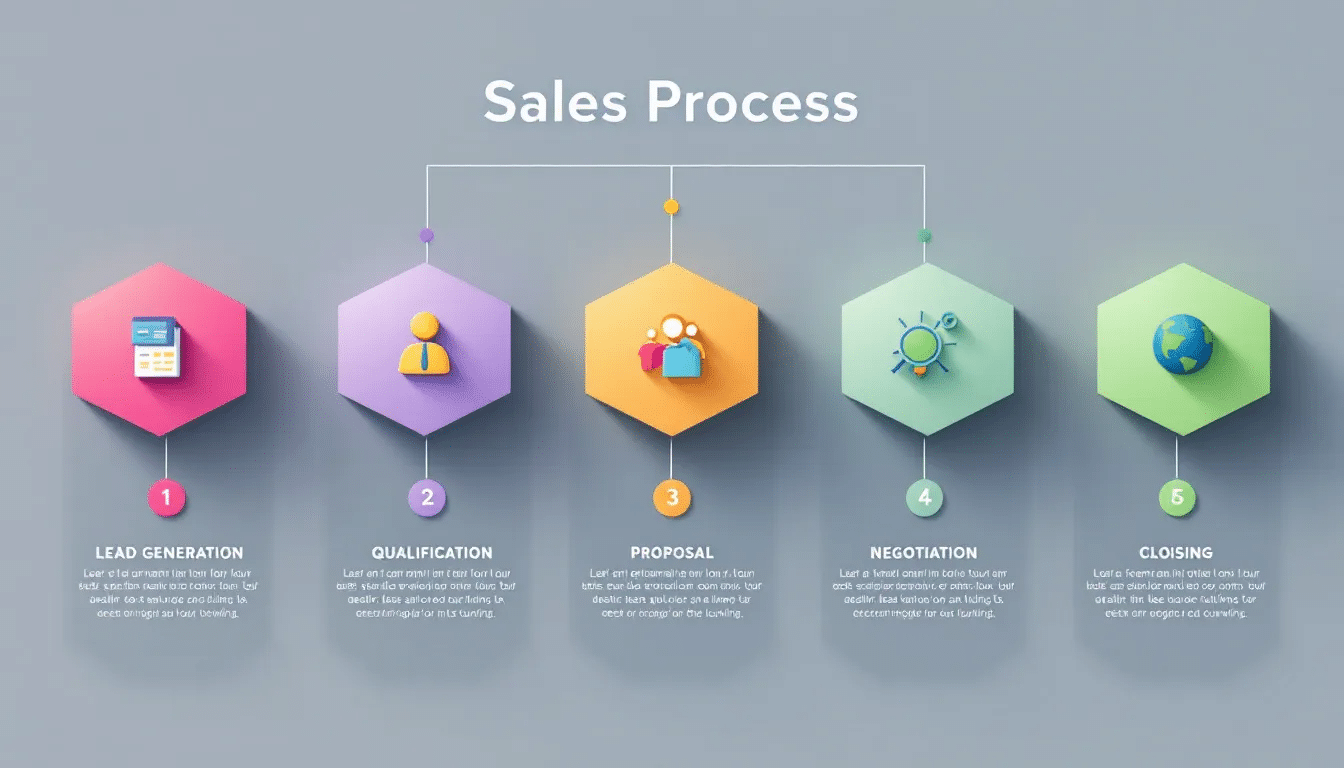Master the Sales Stages: A Step-by-Step Guide to Closing Deals

Sales stages are the essential steps that guide sales teams in converting leads to customers. Understanding why the sales cycle is important is crucial—it provides a structured framework for sales strategies and helps identify bottlenecks and inefficiencies, allowing for faster deal closures. Knowing and mastering these stages can streamline your sales process, making each interaction more effective. In this article, we’ll break down the main sales stages and show you how to optimize each one for greater sales success, while clarifying that a sales rep’s job involves relationship building, managing a sales pipeline, and achieving measurable goals within these stages.
Introduction to Sales
Sales is the powerhouse engine that drives explosive business growth, transforming prospects into loyal, revenue-generating clients who fuel your success. At its core, sales is a precision-engineered process—a battle-tested series of steps known as the sales cycle—that empowers sales teams to build meaningful relationships, decode customer needs, and consistently close deals that matter. A crystal-clear, well-defined sales process is your secret weapon for ensuring consistency and peak efficiency, enabling sales professionals to approach every opportunity with a winning roadmap that delivers results.
For sales teams ready to dominate their market, mastering the sales cycle means far more than simply following steps; it’s about creating a repeatable success system that consistently delivers outstanding outcomes. By embracing a proven, results-driven sales process, businesses can dramatically increase their win rates, exceed customer expectations, and smash their revenue targets with Swiss-like precision. Whether you’re a seasoned sales champion or stepping into this dynamic field, understanding the core fundamentals of the sales process and how to seal deals with confidence is your first step toward building a high-performing sales powerhouse that scales faster and delivers exceptional results.
Key Takeaways
- Understanding and following a structured sales cycle enhances efficiency and maximizes conversions from leads to customers.
- The seven key stages of the sales cycle—from lead generation to post-sale follow-up—guide sales teams in effectively managing their sales pipelines.
- Utilizing CRM tools and automating sales processes can significantly improve tracking, lead management, and overall sales cycle effectiveness.
- Adopting effective sales methodologies is essential for optimizing the sales process and achieving revenue targets.
Understanding Sales Stages

A sales cycle is a well-defined selling process designed to convert potential customers into buyers through a series of structured steps. This systematic approach not only brings clarity to sales reps but also enables sales teams to take the right actions at the optimal times, enhancing overall efficiency. In the competitive world of B2B sales, a structured sales process is key to achieving consistent success in the sales cycle process. The role of a sales rep is crucial in navigating this process effectively. Using a CRM helps organize and track each sales cycle stage, allowing teams to optimize the process and improve conversion rates.
Sales stages guide teams from prospecting to closing the sale, ensuring that each step is meticulously followed to maximize conversions. Clarifying these stages helps sales reps prioritize resources and leads effectively, ultimately leading to more successful deals. Moreover, aligning the sales cycle with buyers’ needs is essential for addressing their challenges and building meaningful relationships that directly impact sales outcomes, which is a crucial aspect of a sales rep’s job within a sales organization. Mapping sales stages to the buyer’s journey helps sales teams visualize and standardize each phase of the buying process, improving sales strategy and customer engagement.
A well-defined sales cycle also fosters better collaboration among sales team members, reducing ambiguity and allowing for a more focused approach to nurturing relationships. By understanding and leveraging the different stages of the sales cycle, sales leaders can optimize their strategies, resulting in a healthier sales pipeline and improved sales performance.
Sales Strategy and Planning
A winning sales team thrives on game-changing sales strategies and precision planning that consistently crushes sales targets. Your sales strategy becomes your ultimate competitive weapon—a comprehensive blueprint that empowers sales teams to identify high-value prospects, tackle their most pressing challenges, and deliver irresistible sales presentations that close deals. The most effective sales strategies are built on deep market intelligence, cutting-edge industry insights, and laser-focused understanding of what drives your ideal clients to say yes.
Sales planning is your strategic foundation for sales domination. It means setting ambitious yet achievable sales targets, deploying resources like a champion, and crafting sales forecasts that keep you ahead of the competition. Sales cycle management becomes your secret weapon in this process, enabling sales teams to track every critical stage and ensure leads flow seamlessly through your high-converting sales pipeline. Lead qualification transforms into your efficiency multiplier, empowering sales reps to channel their energy into the most lucrative opportunities that deliver maximum results.
By continuously analyzing industry trends and customer intelligence, sales managers unlock the power to revolutionize their approach, anticipate market shifts like industry leaders, and fine-tune their sales presentations to resonate powerfully with potential customers. A masterfully executed sales strategy and planning process positions sales teams to dominate their market, stay miles ahead of competitors, and consistently shatter their sales goals while building lasting client relationships.
The 7 Key Sales Stages

Sales cycles typically consist of five to seven stages, each playing a critical role in guiding potential buyers through the buying process. Each sales pipeline stage represents a distinct phase in the sales process, helping teams track customer progression and manage sales activities. Understanding these sales pipeline stages and their order is essential for sales teams to manage their sales pipelines effectively and achieve their sales cycle stages targets.
In this section, we will delve into the seven key stages of the sales cycle, which are essential sales process steps:
- Lead Generation
- Initial Contact
- Lead Qualification
- Sales Presentation
- Handling Objections
- Closing the Deal
- Post-Sale Follow-Up
Each stage is designed to move prospects closer to becoming paying customers, ensuring a structured and effective sales process. A key purpose of these stages is to qualify leads at each step, ensuring only the most promising prospects advance.
Lead Generation
Lead generation is the first stage of the sales pipeline and is crucial for adding potential customers to the sales process. Effective lead generation strategies can include:
- Cold outreach
- Networking
- Social media interactions
Building meaningful connections through networking events and social media can significantly enhance lead generation efforts, making it easier to generate leads and attract potential customers.
Thorough research is vital to understand your prospective customer better. Identifying your target customer is essential, as it allows you to tailor your lead generation strategies to reach and engage the right audience. Creating ideal customer profiles for your ideal customers, observing their businesses, and maintaining contact even if they’re not ready to buy are essential steps in this stage. Focusing on these strategies allows sales teams to generate quality leads and ensure a healthy sales pipeline.
Initial Contact
Making the initial contact with potential leads is a critical step in the sales process. Understanding who you are contacting and tailoring your outreach methods accordingly is essential for effective marketing campaigns. Personalized outreach methods, such as tailored emails and targeted social media platforms messages, greatly improve the chances of engaging potential leads.
Matching your communication method to the lead’s preferences is crucial. It’s also important to consider industry norms. Avoid sending brochures or flyers when initiating contact with a prospect. Instead, utilize a pre-contact strategy that creates curiosity, enhancing the effectiveness of your initial communication.
Lead Qualification
Qualifying leads is a crucial stage in the sales process as it involves assessing their interest, budget, decision-making authority, and specific needs to determine which leads are most likely to become a potential customer through targeted engagement and qualification strategies. Important criteria for lead qualification include:
- Company size
- Budget
- Specific pain points
- Interest
- Decision-making authority
Engaging with decision-makers early can significantly reduce the length of the sales cycle. During the sales qualification phone calls, the focus should be on understanding their problems and determining if you can provide a solution. Qualified leads advance to the next stage with a higher chance of closing a sale.
Sales Presentation
A compelling sales presentation is key to moving prospects closer to closing the deal. To create an effective presentation:
- Conduct thorough research to understand the prospect’s pain points and how your product or service can address them.
- Link your offer with the challenges faced by the prospect.
- Consider their budget and long-term aspirations.
Emphasize the benefits of your product or service and how it addresses the customer’s struggles. A successful sales presentation should offer relevance, targeted solutions, and personalization.
Integrating a story into your sales pitch can help engage prospects by relating to their pains.
Handling Objections
Handling objections is a natural part of the sales process. Prospects often have common sales objections, which can include:
- Concerns about price versus value
- Risk
- The content of the offer
- Contract terms Salespeople should prepare scripts for sales objection to increase their readiness.
Active listening is an important skill to demonstrate when addressing sales objections. Understanding the underlying reasons for a prospect’s objections is crucial for effectively addressing their concerns and building trust. After handling objections, move into the final stage of the sales process.
Closing the Deal
Closing the deal often involves navigating negotiations and addressing any last-minute concerns to finalize the sale. A successful sales proposal can make the difference between winning or losing a sale, incorporating essential elements like pricing and terms.
Some clients may need more reassurance and time to consider, making it important to discuss remaining steps and stakeholders that need to sign off. After closing deals, answer any remaining questions and provide next steps, while considering additional value like free offerings to aid closure.
Post-Sale Follow-Up
Post-sale follow-up is crucial for ensuring customer satisfaction and maintaining relationships with existing customers. Regular follow-ups with potential clients and new customers can foster long-term loyalty and potentially lead to future sales, enhancing customer retention.
Providing support, onboarding assistance, and regular check-ins are essential activities in post-sale follow-up. Asking satisfied customers for customer referrals can lead to new business opportunities and is a key aspect of this stage.
Building a Healthy Sales Pipeline
A robust sales pipeline serves as the powerhouse behind sustained sales success. It delivers a continuous flow of qualified prospects ready for engagement, nurturing, and conversion—ensuring your sales teams never face empty pipelines or missed targets. Building and maintaining this revenue-generating engine demands a strategic approach to lead generation, smart prospect qualification, and precise management of every critical stage in your sales cycle.
Sales reps become the driving force in this process by mastering the buyer’s journey and delivering compelling sales presentations that directly solve prospect pain points and address urgent business needs. Every stage of your sales pipeline—from that crucial first contact through deal closure—must be optimized for maximum conversion rates and consistent target achievement. Advanced sales cycle management tools and proven techniques empower your sales teams to track real-time progress, eliminate costly bottlenecks, and fine-tune their approach for breakthrough results that exceed expectations.
Customer satisfaction becomes your secret weapon for pipeline acceleration. Delighted customers transform into powerful referral sources and loyal repeat buyers, continuously fueling your pipeline with high-quality prospects. Sales enablement resources and cutting-edge training programs ensure your sales reps stay equipped with the latest industry knowledge and proven skills to engage potential customers with confidence and expertise. By focusing on these game-changing elements, businesses build an unstoppable sales pipeline that drives long-term growth and delivers exceptional success.
Sales Training and Coaching
Sales training and coaching are the game-changers of any winning sales operation, empowering teams to crush the competition and smash revenue targets. In today’s hyper-competitive marketplace, ongoing training isn’t just nice-to-have—it’s your strategic weapon for dominating every stage of the sales cycle and delivering exceptional results.
A comprehensive sales training program arms your reps with the skills and knowledge to master the entire sales journey. Training should hit the essentials: lead qualification, sales strategy, and cycle management—ensuring every rep can identify and solve potential customers’ pain points with total confidence. Role-playing exercises and real-world simulations help teams practice handling objections, perfect their pitch, and boost conversion rates. No more missed opportunities.
Effective sales coaching goes way beyond formal training sessions. It’s about regular feedback, personalized guidance, and actionable insights from sales managers who are committed to developing their teams. By working closely with reps, managers can pinpoint improvement areas, tailor coaching to individual needs, and help reps sharpen their approach at every stage. This hands-on support is crucial for maintaining peak performance—especially when navigating complex cycles or overcoming tough objections.
Sales enablement tools and technology play a pivotal role in modern training and coaching. By providing access to up-to-date resources, customer data, and best practices, these tools streamline the sales process and empower reps to deliver compelling pitches that resonate with potential customers. Continuous learning thrives through online webinars, peer-to-peer mentoring, and regular check-ins, fostering a culture of growth and adaptability within your sales team.
Best Practices for Each Sales Stage

A structured sales cycle helps sales representatives take appropriate actions at the right time, facilitating the closure of deals. Aligning the sales pipeline with revenue targets enablement goals optimizes every stage for revenue generation and identifies customer pain points, including corresponding sales activities.
Aligning sales and marketing teams is crucial for improving lead generation, customer messaging, and sales pipeline management. Collaboration between these teams enhances efficiency and drives better revenue outcomes.
To implement changes based on results and ensure team alignment, it is important to track sales metrics and KPIs. Meaningful customer interactions require active listening, asking insightful questions, and tailoring communication. This section will cover best practices for each stage of the sales cycle.
Tracking Conversion Rates
Tracking conversion rates between sales stages is crucial for identifying bottlenecks and improving efficiency in the sales process. Calculate the conversion rate between sales stages by dividing the number of opportunities in one stage by the number in the next stage.
Regularly analyzing conversion rates can reveal trends that inform strategies for improving sales processes. Comparing these rates over time helps highlight stages where performance may be lacking.
Utilizing CRM Tools
Implementing CRM tools allows sales teams to streamline processes and track vital sales metrics more effectively. A CRM organizes leads, deals, and tasks in one place; tracks conversion rates and sales cycle length.
Sales enablement tools provide sales teams with resources and sales strategies to meet buyers’ needs. Automation tools can enhance lead management and tracking, ensuring timely responses to customer inquiries.
Aligning with Customer Journey
Aligning sales actions with the customer journey can optimize interactions and increase conversion rates. Mapping the buyer’s journey aids sales teams in understanding customer problems better, leading to improved targeting of solutions. Unqualified leads can be passed to the marketing team for nurturing through targeted email campaigns, emphasizing the collaborative role between sales and marketing in converting leads.
During the customer journey, focus on the following:
- Awareness stage: Provide valuable content and information to your target audience.
- Consideration stage: Provide personalized solutions.
- Address the pain points of your audience.
- Streamline the purchasing process.
- Highlight clear advantages to aid in decision-making during the buyer’s journey.
Measuring Sales Cycle Effectiveness

Making decisions based on customer data and tracking results consistently is essential for understanding sales cycle effectiveness. Sales teams can optimize their process by identifying and improving weak areas through data analysis. Tracking monthly revenue is also crucial, as it enables financial forecasting and helps measure business growth based on sales pipeline analysis.
Scheduling regular meetings to analyze sales data generates insights that guide process improvements. Identifying bottlenecks in the sales funnel and refining communication strategies can enhance sales cycle management.
Average Sales Cycle Length
The duration of the sales cycle can vary significantly based on product price and market maturity. Calculate the current sales cycle length by dividing the total days in a period by the number of deals closed.
To compare your average sales cycle length, assess it against your team’s cycle length and the industry average. Monitoring your sales cycle length can help predict revenue and refine business strategies.
Sales Funnel Analysis
Analyzing your sales funnel is crucial for understanding how leads progress through different stages and for identifying areas for improvement. Tracking conversion rates between sales stages helps identify bottlenecks and informs strategic adjustments to enhance lead management.
Utilizing CRM tools can enhance sales funnel analysis by organizing leads and tracking key metrics, ensuring that sales teams can make data-driven decisions. Measuring the effectiveness of your sales cycle is essential for understanding overall sales performance and refining strategies to increase conversions.
Techniques to Shorten Your Sales Cycle

To reduce the time taken to close a deal, analyze each stage and identify inefficiencies. A well-structured sales pipeline guides the sales team, improves efficiency, identifies issues, and allows for proactive planning.
Shorter sales cycles correlate with more sales growth. Successful businesses tend to operate with short sales cycles. This section will offer practical techniques for reducing the time it takes to close deals.
Automating Sales Processes
Implementing automation can streamline time-consuming tasks, allowing sales teams to focus on higher-value activities. Automation tools can enhance lead management and tracking, ensuring timely responses to customer inquiries. Utilizing AI tools can automate repetitive tasks, allowing sales teams to focus on strategic activities.
Automation in sales processes helps streamline workflows and accelerate response times.
Enhancing Sales Training
Implementing a comprehensive training program can enhance the skills of salespeople and improve overall cycle efficiency. Ongoing education and training can significantly impact a sales team’s ability to address customer needs effectively.
Regular training on new technologies helps sales teams adapt and improve their performance while staying updated on industry trends. Incorporating real-world scenarios in training better prepares salespeople for actual challenges they may face.
Sales Cycle Management Tips
Regular assessments of the sales process can help identify inefficiencies and areas for improvement. Key strategies include:
- Evaluating the sales pipeline to ensure leads are moving effectively and to measure pipeline health.
- Automating processes where possible to improve overall sales cycle management.
- Allowing sales reps to focus on selling rather than administrative tasks.
Keeping accurate records in the sales cycle helps identify patterns and trends affecting sales performance. Regular data cleanups on the pipeline ensure information remains current and relevant. Following specific best practices for sales cycle management is suggested for optimizing processes.
Summary
Mastering the sales stages is essential for driving consistent sales success. By understanding and implementing a structured sales cycle, sales teams can transform potential buyers into paying customers efficiently. Each stage, from lead generation to post-sale follow-up, plays a vital role in building relationships, addressing customer needs, and closing deals.
Incorporating best practices, tracking metrics, and leveraging tools like CRM systems enhance the effectiveness of the sales process. By continuously measuring and refining the sales cycle, sales teams can achieve shorter sales cycles, increased customer satisfaction, and ultimately, higher revenue. Embrace these strategies to elevate your sales game and secure long-term success.
Frequently Asked Questions
Why is it important to have a structured sales cycle?
Having a structured sales cycle is crucial as it offers clarity and direction for sales representatives, significantly improving efficiency and increasing the chances of closing deals. This framework allows for strategic decision-making at each stage of the process.
How can I improve lead generation efforts?
To improve your lead generation efforts, focus on combining cold outreach, networking, and social media interactions while understanding your prospects through thorough research. This approach will help you build meaningful connections and drive more effective results.
What are the key criteria for qualifying leads?
Key criteria for qualifying leads include assessing the prospect’s interest, budget, decision-making authority, company size, and specific pain points. Engaging with decision-makers early enhances the likelihood of a successful conversion.
How can automation tools help in sales processes?
Automation tools can significantly improve sales processes by streamlining tasks and enhancing lead management, enabling teams to prioritize higher-value activities and respond promptly to customer inquiries. This efficiency ultimately drives better sales outcomes.
What are the benefits of post-sale follow-up?
Post-sale follow-up is essential for ensuring customer satisfaction and fostering long-term loyalty, which can ultimately lead to additional sales and referrals. Engaging with clients after the sale strengthens relationships and demonstrates your commitment to their ongoing success.